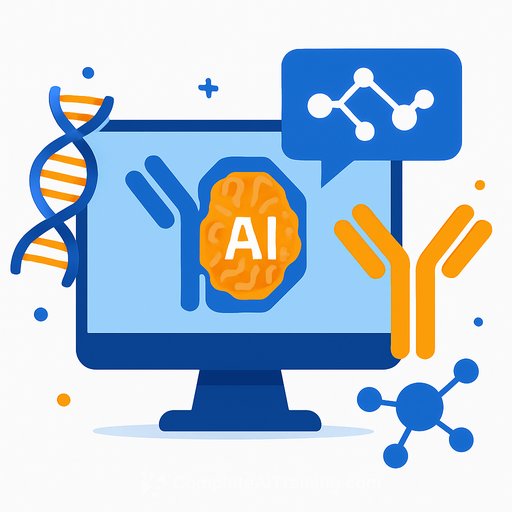AI-designed antibodies from scratch: a new path for drug discovery
Scientists at the University of Washington's Institute for Protein Design have used AI to design antibodies from the ground up. It's a sharp pivot from animal immunization toward programmable molecules built to hit known targets. For a $200B industry under pressure to reduce risk and time-to-candidate, this is worth paying attention to.
The work, from David Baker's lab at IPD and collaborators, appears in Nature. It extends years of progress in AI-guided protein design into the antibody space with convincing wet-lab validation.
Why this matters
Traditional antibody discovery relies on immunizing animals and sifting for binders. It's powerful, but slow, costly, and hit-or-miss. AI-first design promises tighter control: define the binding site, generate sequences that fit, test, iterate.
"It was really a grand challenge - a pipe dream," said Andrew Borst, Head of Electron Microscopy R&D at IPD. Now that engineered antibodies bind their intended targets, he adds, the work "can go on and it can grow to heights that you can't imagine right now."
How they did it
The team trained models on protein structure-function relationships and used them to propose new molecular designs that solve specific binding problems. Instead of tweaking what nature gives you, the system drafts fresh antibody loops to grip chosen epitopes.
They focused on the six flexible loops at the tips of the antibody (the binding site). "We are starting totally from scratch - from the loop perspective - so we're designing all six," said Robert Ragotte, a postdoctoral researcher at IPD. "But the rest of the antibody, what's called the framework, that is actually staying the same."
Keeping a human antibody framework is a practical call. It aims to lower immunogenicity risk while allowing high specificity at the binding interface.
What the tests showed
Designs were challenged against real targets, including hemagglutinin on flu viruses and a toxin from C. difficile. The binding modes in the lab matched model predictions: right shape, right site, on-target.
"They were binding in the right way with the right shape against the right target at the spot of interest that would potentially be useful for some sort of therapeutic effect," Borst said. Tight loops between computation and experiment helped refine designs fast.
Open tools and early commercialization
The software used for antibody design has been released on GitHub, inviting other labs to test and extend the approach. The work is also documented in Nature for a deeper technical read.
Parts of the technology are licensed to Xaira Therapeutics for further development, signaling an on-ramp to translation.
What to watch next (for researchers)
- Developability: improve solubility, stability, and expression without losing affinity or specificity.
- Affinity maturation: combine in silico optimization with directed evolution to push KD down while preserving epitope targeting.
- Immunogenicity: validate that human frameworks and sequence filters reduce T-cell epitope risk; track post-translational liabilities.
- Structural validation: confirm predicted binding modes via cryo-EM or X-ray; cross-check paratope-epitope contacts.
- Manufacturability: assess yields in CHO/yeast, glycosylation profiles, aggregation propensity, viscosity, and formulation.
- Benchmarking: head-to-head against phage/yeast display and hybridoma on speed, cost, hit rate, and epitope coverage.
- Data strategy: curate diverse binders and non-binders; include hard negatives and developability labels to guide models.
Practical takeaways
- If you run antibody discovery, consider adding AI-first loop design as a parallel track to your display platforms.
- Integrate rapid biophysical screens (SPR/BLI, DSC, DSF) to close the design-measure-learn loop in days, not months.
- Lock down assays that report the exact epitope and binding geometry; that's where in silico predictions are most valuable.
- Plan early for CMC: sequence liabilities, glycan hotspots, and stress testing should inform design from round one.
The bottom line: AI can now draft full binding sites for antibodies and hit real targets with the expected geometry. It's early, but the path to programmable biologics is getting clearer-provided we solve developability, safety, and scale.
If you're upskilling your team on practical AI methods for R&D, see our curated options by role here: AI courses by job.
Your membership also unlocks:






